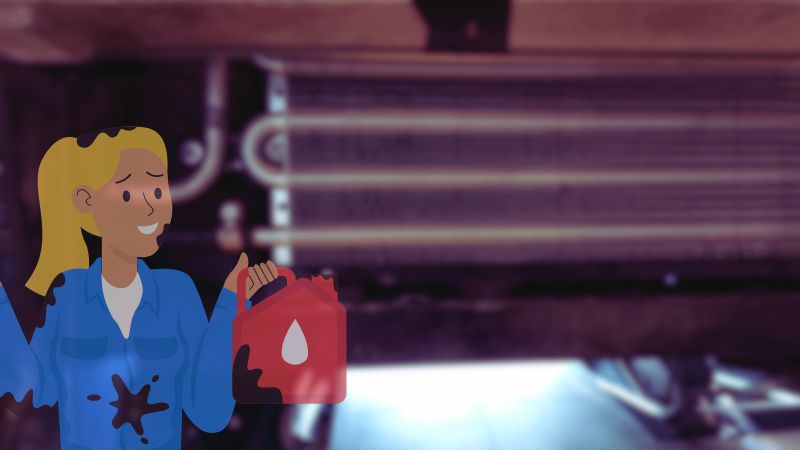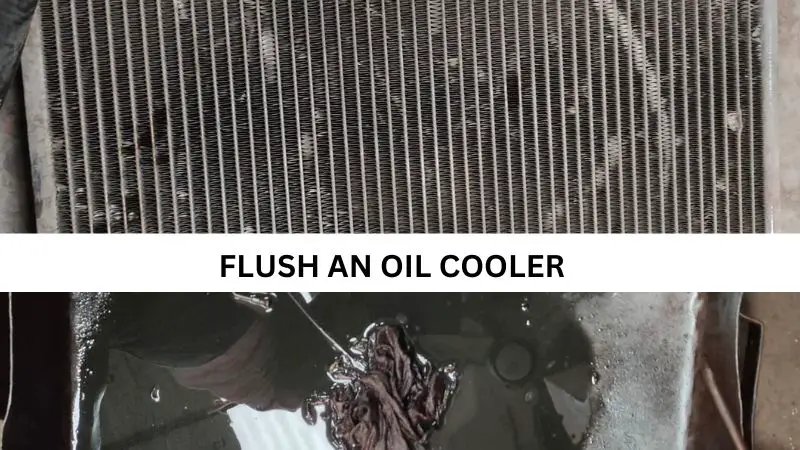An oil cooler transfers heat from oil to another medium, air, or liquid. This Cooler does this job without mixing or direct contact between the two fluids. This job is performed by flowing hot oil through equipment.
These appliances have small channels through which oil flows, And this makes them prone to fouling and getting stuck in debris. Because of this, you should clean the Cooler with cooler-cleaner oil.
In automotive oil coolers, this could be a transmission failure. This debris can damage your expensive equipment in more oversized industrial oil coolers. That’s why cleaning the oil cooler is very important.

What Is Cooler Cleaner Oil?
Cooler cleaner oil can remove rust and hard deposits like lime and corrosion from your oil cooler system. Besides, this cleaner oil can remove any residues from glycol and the same products. You also can use these products for manual cleaning. With this multi-purpose product, you can clean many applications, like solving and cleaning complex contaminants.
Lube Oil Cooler Cleaning
Lube Oil Cleaner removes oil and lube oil mixed with hard deposits such as rust and lime. Moreover, this Lube Oil Cleaner can also remove sludge deposits from glycol and Cooler. This cleaner is a versatile product that can handle a variety of applications.
Application:
This oil cleaner is suitable for cleaning lube oil, heat exchangers, lube and fuel oil separators, lube oil tanks, and pipe systems. In fact, it’s best to clean-in-place cleaning equipment.

How To Flush an Oil Cooler?
You can clean or focus your oil cooler like any other sump. If you want, you can use a different method. However your selection should be based on the characteristics of the pollutant. However, let’s learn how to flush an oil cooler.
- Drawdown Filtration:
This way is the mildest flushing technique. Since many machines have no onboard filtration, the frequent use of oil recovery equipment can not only clean the oil. But it can remove sludge and silt from the shell.
- High Turbulence, Low Oil Viscosity:
Improved oil dynamics near engine surface boundaries enhance flushing. The procedure involves enhancing the fluid velocity during the flush and reducing the oil’s viscosity. Generally, a Reynolds number between 4,000 and 6,000 is typically targeted.
- High Flush-Oil Temperature
This technique reduces viscosity and boosts turbulence. Additionally, it enhances oil clarity by scrubbing away stubborn deposits. The target temperature is 175 to 195 degrees Fahrenheit.
- Cycling Flush-Oil Temperature:
Some practitioners have found that bumping the machine with significant temperature changes can cause crusty deposits during flushes. They use heaters to cycle the oil temperature repeatedly in the 100°F range.
- Pulsating Oil Flow
Rapidly changing oil flow rate helps remove irritating contaminants from the nooks and crannies of shells and tubes.
- Wand Flush Tool
This technique is used for large shells with convenient access to clean-out ports. A flushing hose makes a stream of high-velocity oil that blasts away the deposits on a stick. Alternatively, a wand used in suction mode can help lift sediment below the sump floor.
- Chemical Cleaning
Usually, active compounds, like acid and caustic, can help to remove adhesive inorganic deposits. You must remove the oil first from the system.
After flushing, you must flush these chemicals thoroughly from the system, often followed by sedation. Always consult machine and lubricant suppliers before using chemical flushes.
- Reverse Oil Flow
Changing the direction of the fluid flow can be released by separating into the oil.
- Solvent/Detergent Flush
Various solvents and detergents have been used to make flush fluids with varying degrees of success. These include mineral spirits, diesel fuel, engine oil, and detergent packages. They are usually added to the flush fluid at 5% to 15% and then rinsed.
You Can Check: Best Way To Engine Oil Flush
Oil Cooler Cleaning Service:
There are many oil cooler cleaning service companies. Your entire system will collapse if your oil cooler fails because of debris, build-up, and other fouling. So before damaging your Cooler, you should consult with your professional to restore it!
You need to hear what they offer if you’ve settled for a 50% to 80% clean. They will remove 99.9% of debris and fouling in any oil cooler. Similarly, they will clean your oil cooler properly.
Flushing services offer a more affordable option to restore a cooler. Even factory oil coolers contain some debris; This debris is left over from the manufacturing process. You don’t have to buy a new oil cooler with flushing services. They can restore your old Cooler to be as good or better than a new one.
Cleaning Oil Cooler After Engine Failure:
You can use automatic dishwasher soap; it cuts grease but does not foam. Drain the coolant, add water and soap. Start the engine and run it until it reaches operating temperature and the coolant circulates. Run for a few minutes, then turn off. Drain the water when cool & flush with water.
Repeat this process until the oil runs out, at least three times. Now check the radiator and coolant system. In addition, if you are satisfied that it’s clean, flush this system often to eliminate all soap residue. Refill with coolant and replace filter/conditioner.
Is the oil Cooler Clogged?
Have a quality scanner attached to your truck? A proper oil cooler keeps your oil temperature as same as your coolant temperature. It’s maybe 10 to 20° below. That means if your coolant temperature is 200 degrees, your oil temperature will be between 180-200°.
If you have a plugged oil cooler, your oil temperature will exceed your coolant temperature. Actually, you can see these “pids” with a factory-type scan tool. Still, check out your fan clutch and radiator thermostat. Because of overheating problems, your radiator can fail internally.
Some Additional Information
We have attached some additional information for you here. It’s because we hope this will be helpful for you if you want to buy a new oil cooler.
Pacific Oil Cooler:
Radiators and coolers need to be protected as precisely as the engine. That’s why choosing an outstanding, precision-built, and powerful aftermarket product is essential. If you’re glimpsing for a piece that stands the test of time, don’t look at any other place. Proper engine cooling is a click away.
Your vehicle’s engine cooling system is the critical circulation essential for a well-timed machine. If something breaks or starts to malfunction in this system, it can lead to serious engine problems. After that, your engine starts to misfire and even fails to start. With these engine cooling parts, restore your car to running and new.
Aircraft Engine Oil Cooler:
An aircraft oil cooler helps increase the temperature of the aircraft oil while the engine is running. Therefore, the oil will flow through a heat exchanger if the temperature rises. This heat exchanger uses air or fuel to lower the oil temperature. Once the oil temperature drops to a safe level, it is returned to the system. Thus, the valve is closed, continuing to reroute oil unless it reaches the triggering temperature.
After heating the oil, this valve opens. Oil cooling is essential for systems to improve aircraft performance significantly. But this vital tool is often overlooked until a significant problem, such as a crack or leak, occurs.
Over time, these carbon deposits and oil sludge will build up. And they can reduce your aircraft’s oil cooler efficiency. If your oil cooler isn’t working, it may be time to inspect it.
Final Word:
In short, deposits are cleaned without mechanical effects and without removing the heat exchanger from the equipment. It is possible to clean the most inaccessible places.
A preliminary analysis of the deposits allows for the optimal chemical composition of the cleaner. And the operating parameters of the flushing equipment to remove the rust and deposits.
The cleaner is absolutely passive to the components of the heat exchanger pipes. The cooler cleaner oil guarantees their integrity after finishing the wash.
Read:
Everything You Need to Know About Oil Cooler Replacement Cost
Why Does the Oil Cooler Line Leaking At Radiator? Causes And Solutions
